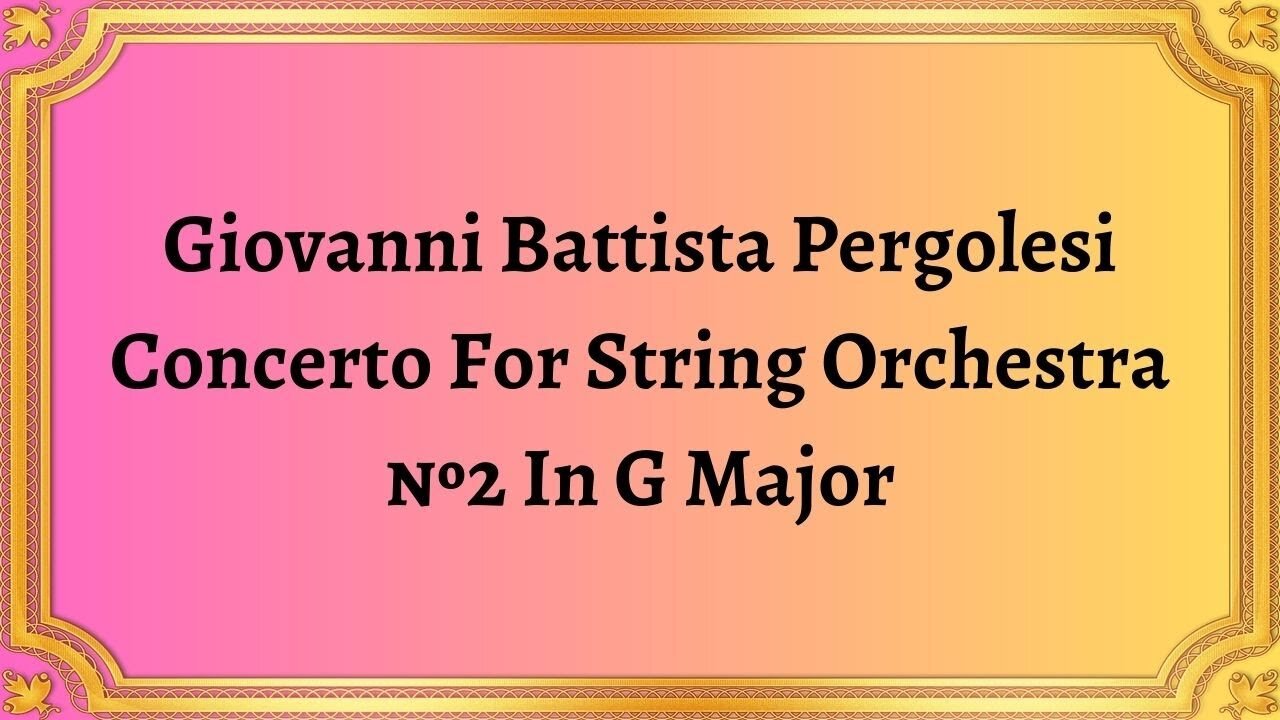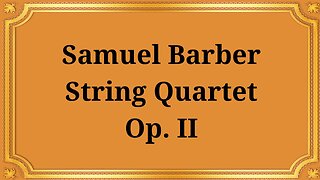Premium Only Content

Giovanni Battista Pergolesi Concerto For String Orchestra, №2 In G Major
#GiovanniBattistaPergolesi #ConcertoForStringOrchestra #GMajor #Baroque #Allegro #Adagio #Vivace #Harmony #Counterpoint #Tonality #StringEnsemble
Publication date 1950
ANGELICUM ORCHESTRA, Milan E. GERELLI, Conductor
The Giovanni Battista Pergolesi Concerto for String Orchestra, No. 2 in G Major, is a stunning and elegant example of Italian baroque music. Pergolesi, who was born in 1710 and died at only 26 years old, was best known for his dramatic works, but this concerto showcases his mastery of instrumental composition.
The concerto is composed of three movements, each with its own distinctive character and mood. The first movement is an allegro that begins with a lively and cheerful theme, played by the violins, which is then picked up by the rest of the strings. The music is light and graceful, featuring lively rhythms and inventive melody lines.
The second movement, marked adagio, is more somber and contemplative. The pace slows down, and the strings play flowing, lyrical phrases that are full of emotion and expression. The use of dynamics and phrasing adds depth and intensity to the music, creating a powerful and poignant effect.
The final movement is a vivace, or fast, playful piece that brings the concerto to a rousing close. The music is full of energy, with virtuosic runs and playful rhythms that showcase the technical skill of the string players. The movement is full of vitality and excitement, bringing the piece to a dynamic and thrilling conclusion.
One of the unique features of this concerto is its use of harmonies and counterpoint in the string ensemble, which gives the music a full and lush sound. Pergolesi also uses unexpected harmonic twists and shifts in tonality, creating a sense of surprise and drama that is typical of the baroque era. The interplay between the different sections of the strings is also a notable feature of the composition, with each section taking turns to play different parts of the melody.
In conclusion, the Giovanni Battista Pergolesi Concerto for String Orchestra, No. 2 in G Major, is a wonderful example of Italian baroque music. Its elegant melodies, inventive rhythms, and use of harmonic counterpoint make it a delightful and engaging composition. The concerto has become a popular work in the string orchestra repertoire, and is enjoyed by audiences and performers alike for its technical virtuosity and musical beauty.
You have the opportunity to support the channel https://destream.net/live/RadSiarAl/donate
-
 16:45
16:45
Classical music_Music Inspiration
4 days agoSamuel Barber String Quartet, Op. II
512 -
 8:44:47
8:44:47
SpartakusLIVE
9 hours ago$20,000 Hide and Seek Tourney w/ Stonemountain64 || #1 Rat wins the BIG CHEESE
49.3K -
 2:34:02
2:34:02
Barry Cunningham
5 hours agoLISA COOK | ADAM SCHIFF | LETITIA JAMES | ARE THEY BEING SACRIFICED BY THE DEEP STATE?
68.4K38 -
 1:36:19
1:36:19
Flyover Conservatives
13 hours agoOnly 17% of Millennials Hit These 5 Adult Milestones—Why?; What If Childhood Trauma Is Behind Your Health Problems? - Dr. Troy Spurrill | FOC Show
18.6K3 -
 4:49:04
4:49:04
HogansAlleyHero
14 hours ago💥CHASING DOPAMINE💥✅TRUMP SAYS BATTLEFIELD IS THE BEST✅
24.7K1 -
 1:57:40
1:57:40
MattMorseTV
5 hours ago $0.66 earned🔴Trump just SHATTERED the PROJECTIONS.🔴
42.1K31 -
 2:32:19
2:32:19
megimu32
4 hours agoOTS: From Star Search to Superstardom
29K4 -
 1:56:21
1:56:21
Joker Effect
3 hours agoInterviewing GREENMAN! Looks like he is coming to Rumble! Let's give him a warm welcome! REAL TALENT
17.1K1 -
 1:07:21
1:07:21
Anthony Rogers
10 hours agoEpisode 380 - Is Pain All In Your Head?
11.9K3 -
 1:46:17
1:46:17
Glenn Greenwald
7 hours agoGlenn Takes Your Questions on Censorship, Epstein, and More; DNC Rejects Embargo of Weapons to Israel with Journalist Dave Weigel | SYSTEM UPDATE #505
112K7